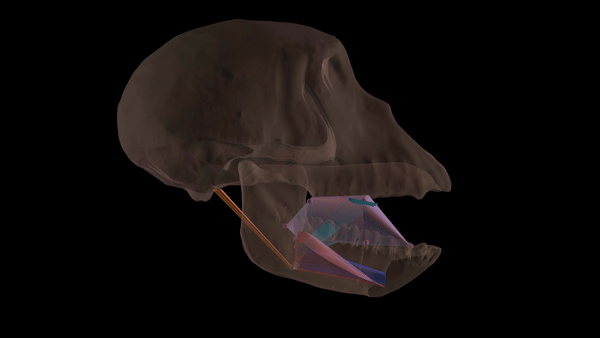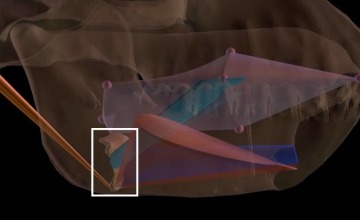We swallow hundreds of times a day while eating, talking, reading, watching TV, and even sleeping. It’s an action we rarely think about, yet proper swallowing is vital to our survival. Swallowing involves a highly coordinated series of movements of the jaw and muscles in and around the tongue. A glitch at any point can lead to disordered swallowing, known as dysphagia. The condition can make eating less enjoyable and may lead to choking, weight loss, and pneumonia. Dysphagia can be a complication of certain conditions, including craniofacial defects, temporomandibular joint disorders, and surgical and radiation therapies for head and neck cancer. Scientists are trying to better understand the mechanics of swallowing to improve treatment of dysphagia.
In an NIDCR-funded study led by a group at the University of Chicago, scientists used advanced visualization techniques to image monkeys while they swallowed food. The monkeys’ jaw and tongue movements were captured in unprecedented detail, as shown in the reconstructed image above. During swallowing, the base of the tongue (light pink) moves toward the back of the mouth, driving food down the throat.
The traditional thinking was that this action is caused by muscles in or around the tongue squeezing or pulling it back. Instead, the imaging shows that a bone at the base of the tongue called the hyoid (the knobby structure outlined in white at right) drops below the base of the jaw then is driven up and forward like a piston, squeezing the base of the tongue and the food backward into the throat. Because our tongue, hyoid, and jaws are similar to monkeys, the researchers think this process happens in humans, too.
“The findings suggest that rehabilitation and surgeries for patients with dysphagia may be improved by targeting the hyoid and its muscles,” says Callum Ross, PhD, senior author and professor of organismal biology and anatomy at the University of Chicago. “This new understanding of swallowing has the potential to improve the lives of many people.”
Reference
XROMM and diceCT Reveal a Hydraulic Mechanism of Tongue Base Retraction in Swallowing. Orsbon CP, Gidmark NJ, Gao T, Ross CF. Sci Rep. 2020 May 19;10(1):8215. doi: 10.1038/s41598-020-64935-z. PMID: 32427836


Comments
Post a Comment